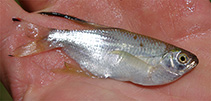Pseudocorynopoma stanleyi Malabarba, Chuctaya, Hirschmann, Oliveira & Thomaz, 2020
Clear-finned dragonfin tetra
Upload your photos and videos
Pictures | Google imagePseudocorynopoma stanleyi
Picture by Petersen, P.
Pictures | Google imagePseudocorynopoma stanleyi
Picture by Petersen, P.
Common names from other countries
Classification / Names आम नाम | उपशब्द | Catalog of Fishes(वर्ग, प्रजाति) | ITIS | CoL | WoRMS | Cloffa
> Characiformes (Characins) > Characidae (Characins; tetras) > Stevardiinae
Etymology: Pseudocorynopoma: Greek, pseudes = false + Greek, koryne = stick + Greek, poma = cover, operculum (Ref. 45335).
Eponymy: Professor Dr Stanley Howard Weitzman (1927–2017) was honoured for his great contribution to our knowledge of Neotropical freshwater fish (see Weitzman, SH). (Ref. 128868), visit book page.
Etymology: Pseudocorynopoma: Greek, pseudes = false + Greek, koryne = stick + Greek, poma = cover, operculum (Ref. 45335).
Eponymy: Professor Dr Stanley Howard Weitzman (1927–2017) was honoured for his great contribution to our knowledge of Neotropical freshwater fish (see Weitzman, SH). (Ref. 128868), visit book page.
Environment: milieu / climate zone / depth range / distribution range पारिस्थितिकी
; स्वच्छ जल, अलवण जल बेनथोपिलाजिक. Tropical
वितरण देश | ऐफ ऐ ओ क्षेत्र | Ecosystems | संयोग | Point map | भूमिका | Faunafri
South America: Brazil and Uruguay.
आकार / वज़न / Age
Maturity: Lm ? range ? - ? cm
Max length : 6.2 cm SL पुल्लिंग / अलिंग; (Ref. 123882); 6.1 cm SL (female)
Max length : 6.2 cm SL पुल्लिंग / अलिंग; (Ref. 123882); 6.1 cm SL (female)
Short description पहचान कुंजी | आकृति विज्ञान | मौरफोमैटरिक्स
पृष्ठीय सौफट रेज़ (सम्पूर्ण) : 9; ऐनल सौफट रेज़: 32 - 37; जानवरों की रीड़ का जोड़: 37 - 39. This species is distinguished from P. heterandria by the number of branched anal-fin rays 32-36 (vs. 35-40 in P. heterandria); presence in males of an intermediate lobe in the distal margin of the anal fin (vs. absence); presence of hooks on the anal-fin rays of the intermediate lobe only (vs. presence of hooks in the branched anal-fin rays of the anterior lobe); presence of marks coloured in pink, black and white at the tips of the caudal-fin lobes in both sexes (vs. absent). It differs from P. doriae in both sexes by the arrangement of the white, red and black marks at the tip of the dorsal lobe of the caudal fin and in mature males by the absence of black spots at the distal tip of the pectoral fin and by the absence of black spots in the distal tip of the rays of the anterior lobe of the anal fin (vs. present in P. doriae); differs further by the growth patterns of the caudal peduncle length in females and of the anal-fin base length in males and by 87 mutational steps in mtDNA sequences (COI and ND2) (Ref. 123882).
Life cycle and mating behavior परिपक्व अवधि | पुनरुत्पत्ति | मछलीऔ का अंडे देना | अंडे | Fecundity | लार्वा
Main reference
Upload your references | संदर्भ | संयोजक | सहयोगीयो
Malabarba, L.R., J. Chuctaya, A. Hirschmann, E.B. de Oliveira and A.T. Thomaz, 2020. Hidden or unnoticed? Multiple lines of evidence support the recognition of a new species of Pseudocorynopoma (Characidae: Corynopomini). J. Fsh. Biol. 98(1):219-236. (Ref. 123882)
Threat to humans
Harmless
Human uses
FAO(Publication : search) | FishSource |
अधिक जानकारी
Trophic ecology
खाद्य पदार्थ
संघटक आहार
आहार खपत
Food rations
परभक्षी
खाद्य पदार्थ
संघटक आहार
आहार खपत
Food rations
परभक्षी
Ecology
पारिस्थितिकी
Home ranges
पारिस्थितिकी
Home ranges
Population dynamics
Growth parameters
Max. ages / sizes
Length-weight rel.
Length-length rel.
Length-frequencies
Mass conversion
भर्ती
बहुतायत
Growth parameters
Max. ages / sizes
Length-weight rel.
Length-length rel.
Length-frequencies
Mass conversion
भर्ती
बहुतायत
Life cycle
पुनरुत्पत्ति
परिपक्व अवधि
Fecundity
मछलीऔ का अंडे देना
Spawning aggregations
अंडे
Egg development
लार्वा
लारवल गतिकी
पुनरुत्पत्ति
परिपक्व अवधि
Fecundity
मछलीऔ का अंडे देना
Spawning aggregations
अंडे
Egg development
लार्वा
लारवल गतिकी
Anatomy
गिल क्षेत्र
Brain
Otolith
गिल क्षेत्र
Brain
Otolith
Physiology
Body composition
Nutrients
Oxygen consumption
Swimming type
Swimming speed
Visual pigments
Fish sound
Diseases & Parasites
Toxicity (LC50s)
Body composition
Nutrients
Oxygen consumption
Swimming type
Swimming speed
Visual pigments
Fish sound
Diseases & Parasites
Toxicity (LC50s)
Genetics
आनुवंशिकी
Heterozygosity
हैरेटिबिलटी
आनुवंशिकी
Heterozygosity
हैरेटिबिलटी
साधन
E-book | कार्यक्षेत्र पथप्रदर्शक | लंबाई आवृति इंद्रजालिक | जीवन-इतिहास उपकरण | बिन्दु नक्शा | Classification Tree
| Catch-MSY |
Special reports
Download XML
Summary page | Point data | आम नाम | Photos
इंटरनेट स्रोत
Aquatic Commons | BHL | Cloffa | Websites from users | Check FishWatcher | CISTI | Catalog of Fishes(वर्ग, प्रजाति) | DiscoverLife | ECOTOX | Faunafri | Fishtrace | GenBank(genome, nucleotide) | GloBI | GOBASE | | Google Books | Google Scholar | Google | IGFA World Record | MitoFish | राष्ट्रीय आंकड़ासंचय | Otolith Atlas of Taiwan Fishes | PubMed | Reef Life Survey | Scirus | SeaLifeBase | Tree of Life | Wikipedia(Go, खोज) | World Records Freshwater Fishing | Zoobank | Zoological Record
Estimates based on models
Phylogenetic diversity index (Ref. 82804): PD50 = No PD50 data [Uniqueness, from 0.5 = low to 2.0 = high].
Bayesian length-weight: a=0.01585 (0.00672 - 0.03736), b=3.00 (2.80 - 3.20), in cm Total Length, based on LWR estimates for this (Sub)family-body shape (Ref. 93245).
Trophic level (Ref. 69278): 3.0 ±0.4 se; based on size and trophs of closest relatives
लौटाव (Ref. 120179): ऊंचा, न्यूनतम जनसंख्या दुगनी समय अवलागत 15 महीने। (Preliminary K or Fecundity.).
Fishing Vulnerability (Ref. 59153): Low vulnerability (10 of 100).




